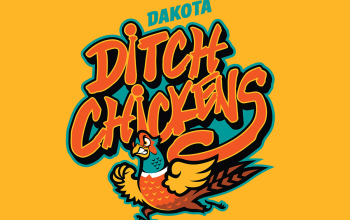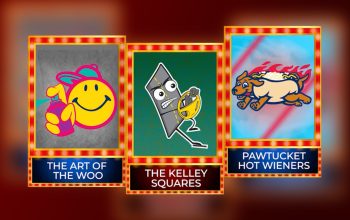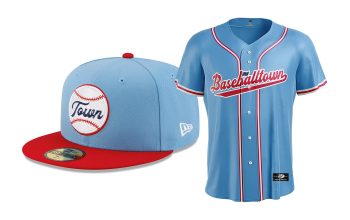
The 2019 season brought an armful of change for the Triple-A baseball team in Las Vegas. After 36 years playing in downtown Las Vegas at Cashman Field—a symmetrical 18 seasons as the Stars and 18 as the 51s—the team moved to a jazzy new ballpark in nearby Summerlin, signed a player development contract with a new parent club (the A’s), and adopted a completely new identity. In December 2018, amid the craziness of baseball’s Winter Meetings, ballpark construction, and VIP hardhat tours of the site, the team unveiled their new look.
“As our president Don Logan said, you only have one chance to totally rebrand something when you get a new ballpark, coinciding with a new affiliation,” said Jim Gemma, the franchise’s longtime media director.
The team took that opportunity to pay homage to the namesake of the corporation that has owned the team since 2013—eccentric investor, Hollywood mogul, philanthropist, engineer, and death-defying and record-setting pilot Howard Hughes, who was the subject of the Leonardo DiCaprio film The Aviator.

Per the team’s website:
“The name change pays homage to the company’s namesake, Howard R. Hughes, Jr., one of the twentieth century’s most successful businessmen whose passion for aviation and legacy of innovation includes significant aviation-related firsts and accomplishments. In the H-1 Racer, a plane he designed and built, Hughes set the land speed record of 352 miles per hour in 1935. Hughes went on to set other records, including the fastest coast-to-coast flight in 1937 and the fastest circumnavigation of the globe in 1938, then acquiring and successfully operating major airlines and aviation companies.”
Howard Hughes is certainly an interesting figure to base a team’s identity on. Much of Hughes’s story centers around his success in finance, film, and flight, but his life was not without a certain amount of controversy, or at least intrigue—in 1933 he was booked on suspicion of negligent homicide after a car he was driving struck and killed a pedestrian, he was rumored to be connected to Richard Nixon and Watergate in the 1960s, and before his death in 1976 his behavior became increasingly erratic and reclusive as he took up residence in the penthouses of a series of Las Vegas casinos.
Though it seems the new name was something of a given from the outset of the process, the team went through the public display of a name-the-team contest in April of 2018 (during which our very own Chris Creamer submitted the nickname Aviators).
“Aviators was submitted multiple times, again because of the aviation history here, probably people in tune with who Howard Hughes was,” Gemma said. “But we had everything from Coyotes to—some people wanted to keep the 51s or go back to the Stars. We had all sorts of names.”

The Aviators’ brand, which was largely designed in house, features a color palette inspired by the Las Vegas sunset: navy, orange, tangerine, gold, yellow, and gray. Gemma describes the primary logo (featured on my helmet sundae above) as “a futuristic aviator pilot with the red rock canyon shining in his visor.” The players’ favorite logo, which Gemma says they chose to wear whenever the choice was left to them, features the letters LV for Las Vegas with the landscape silhouetted within the letterforms.

“When you go to New Orleans or you go to Memphis or Nashville, or you’re playing in the All Star Game or the Triple-A National Championship Game if you’re lucky enough to get there,” Gemma said, “people know what LV is, it’s Las Vegas. So that’s why we chose to do that.”
When I interviewed Gemma back in 2014 for a story in this series about the Las Vegas 51s, he intimated that he did not totally love the whimsical nature of the team’s alien-themed brand at the time, and even then he seemed enthusiastic about the notion of a new stadium and brand down the road. Even during this most recent conversation, he indicated that he never fully embraced the old brand: “People knew who the 51s were, whether you liked it or hated it,” he said.

With a new brand that seems much more geared toward grown-ups than kids, Gemma seemed pleased to have gotten his wish.
“You can’t say anything negative about it,” he said. “With what happened with Las Vegas Ballpark, going to the A’s, and then with the Aviators, the merchandise is awesome, the uniforms look great, the color scheme is great, the different selection of hats is great. There’s really nothing but positive things to say about the transformation from Stars to 51s to Aviators.”
Still, though, Gemma said, it’s important that no one takes any of this too seriously: “People have to put this in perspective,” he said. “It’s minor league baseball. We play in the same division as the Chihuahuas, the Isotopes, the Baby Cakes, which will be no longer because they’re going to Wichita. It’s part of the ambiance of minor league baseball, unique nicknames. It’s kind of what’s cool about minor league baseball.”

I went to an Aviators game in April, and while the logo itself has not exactly received critical acclaim (it’s one of the worst reader-reviewed logos of the year on this very site, garnering a 3.6/10 rating), the team has a beautiful new stadium and puts on a terrific in-game experience. It may be that this brand takes a bit of getting used to—between the nuances of Howard Hughes’ story and a suite of logos that is different from what minor league baseball fans have grown accustomed to, perhaps it will take the full 18 years this team is destined to play in Las Vegas for us to embrace visor guy and those canyons reflected in his glasses.







